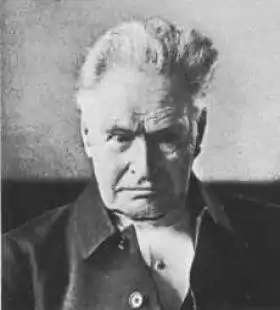Edmund Beckett, 1st Baron Grimthorpe
Edmund Beckett, 1st Baron Grimthorpe, QC (12 May 1816 – 29 April 1905), known previously as Sir Edmund Beckett, 5th Baronet and Edmund Beckett Denison, was a "lawyer, mechanician and controversialist"[1] as well as a noted horologist and architect.
The Lord Grimthorpe | |
|---|---|
 | |
| Born | Edmund (Mackenzie Sidmouth) Beckett Denison 12 May 1816 |
| Died | 29 April 1905 (aged 88) |
| Nationality | British |
| Education | Hall Cross Academy; Eton College |
| Alma mater | Trinity College, Cambridge |
| Occupation | Parliamentary barrister, mechanic, architect |
Biography
Beckett was born at Carlton Hall near Newark, Nottinghamshire, England, and was the eldest son of Sir Edmund Beckett, 4th Baronet, MP for the West Riding of Yorkshire.[2]
He was educated at Doncaster Grammar School for Boys (briefly), then Eton, and went on to read mathematics at Trinity College, Cambridge, where he graduated in the 1838 Tripos with the rank of "30th Wrangler".[2]

Baron Grimthorpe as caricatured by Spy (Leslie Ward) in Vanity Fair, February 1889
Beckett began practising law in 1841 at Lincoln's Inn. He was made a Queen's Counsel in 1854, retiring in 1881.[2] He was elected to the Royal Astronomical Society in 1866. He was elected to the presidency of the British Horological Institute in 1868, a position he accepted on the condition that he should not be asked to attend dinners.[3] He was re-elected annually until his death.[1] In 1877 he was appointed Chancellor and Vicar-General of the Diocese of York.[2] He was created Baron Grimthorpe in 1886. He is sometimes known as Edmund Beckett Denison; his father had taken the additional name Denison in 1816, but the son dropped it on his father's death in 1874. He married Fanny Catherine (23 February 1823 – 8 December 1901), daughter of John Lonsdale, 89th Bishop of Lichfield.
In 1851, he designed the mechanism for the clock of the Palace of Westminster (the Houses of Parliament in London), responsible for the chimes of Big Ben.
In 1868 he worked with W. H. Crossland to design St Chad's Church, Far Headingley in Leeds on land given by his family.

He was also responsible throughout the 1880s and 1890s for rebuilding the west front, roof, and transept windows of St Albans Cathedral at his own expense. Although the building had been in need of repair (and indeed considerable work had already been done since 1856 under the guidance of Sir George Gilbert Scott until his death in 1878, including making the central tower safe, correcting the listing of the south side of the nave, and reconstructing the shrine of Saint Alban), popular opinion at the time held that he had changed the cathedral's character, even inspiring the creation and temporary popularity of the verb "to grimthorpe", meaning to carry out unsympathetic restorations of ancient buildings.[5] Part of Beckett's additions included statues of the four evangelists around the western door; the statue of St Matthew has Beckett's face. He later turned his attentions to St Peter's and then to St Michael's churches, both in the same city. He lived at Batchwood Hall from where he oversaw the restoration work on the cathedral.[6]
He died on 29 April 1905 after a fall, and is buried in the grounds of St Albans Cathedral. His obituary in the Monthly Notices of the Royal Astronomical Society noted his mastery of ecclesiastical law, his publications (ranging from Astronomy without Mathematics to Clocks, Watches, and Bells (1903) to Building, Civil and Ecclesiastical) and noted "there was not a better locksmith in England."[2]
Quotation

- "I am the only architect with whom I have never quarrelled."
References
- Sanders, Lloyd Charles (1912). . Dictionary of National Biography (2nd supplement). London: Smith, Elder & Co. pp. 121–124.
- "Obituary Notices: Fellows:- Grimthorpe, Lord.", Monthly Notices of the Royal Astronomical Society, 66: 174–176, February 1906, Bibcode:1906MNRAS..66S.174., doi:10.1093/mnras/66.4.174b
- Ferriday, Peter (1957), Lord Grimthorpe, 1816–1905, London: John Murray Ltd., p. 63, OCLC 250668435
- Chisholm, Hugh, ed. (1911). . Encyclopædia Britannica. 12 (11th ed.). Cambridge University Press. p. 604.
- Benerjee, Jacqueline. "St Albans Cathedral and Abbey Church, Hertfordshire: A Case History in Victorian Restoration". The Victorian Web. Retrieved 18 January 2008.
While the verb "to Grimthorpe" entered the English language of the time as a pejorative term for such insensitive "restoration," ...
- "Batchwood Hall". St Albans and Hertfordshire Architectural and Archaeological History Society. Retrieved 12 November 2017.
External links

 Works written by or about Edmund Beckett, 1st Baron Grimthorpe at Wikisource
Works written by or about Edmund Beckett, 1st Baron Grimthorpe at Wikisource Media related to Edmund Beckett, 1st Baron Grimthorpe at Wikimedia Commons
Media related to Edmund Beckett, 1st Baron Grimthorpe at Wikimedia Commons- Works by Edmund Beckett Grimthorpe at Project Gutenberg
- Works by or about Edmund Beckett Denison at Internet Archive
- Works by or about Edmund Beckett at Internet Archive
- Edmund Beckett, 1st Baron Grimthorpe at Find a Grave
| Peerage of the United Kingdom | ||
|---|---|---|
| New creation | Baron Grimthorpe 1886–1905 |
Succeeded by Ernest William Beckett |
| Baronetage of the United Kingdom | ||
| Preceded by Edmund Beckett |
Baronet (of Leeds) 1874–1905 |
Succeeded by Ernest William Beckett |